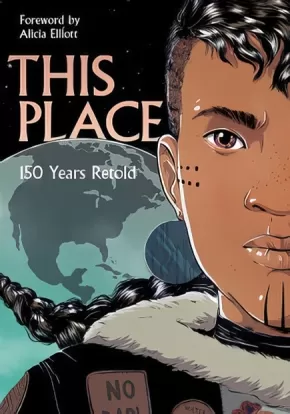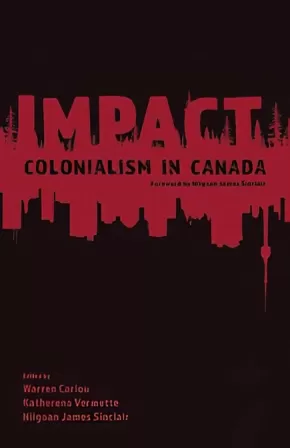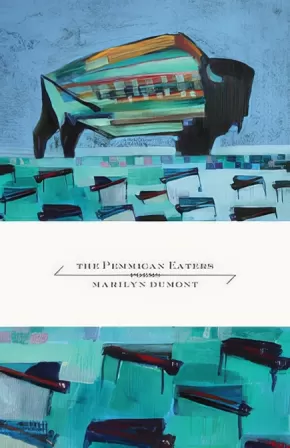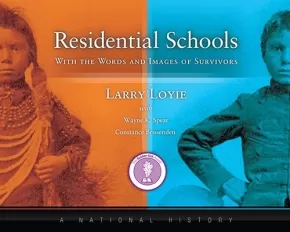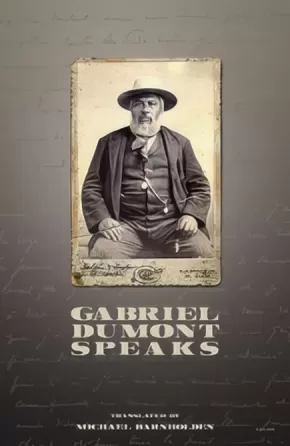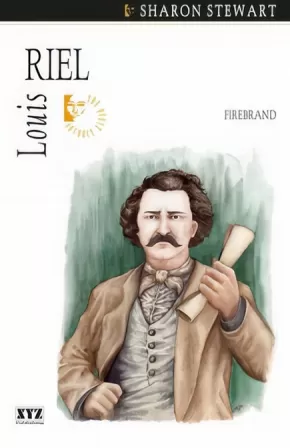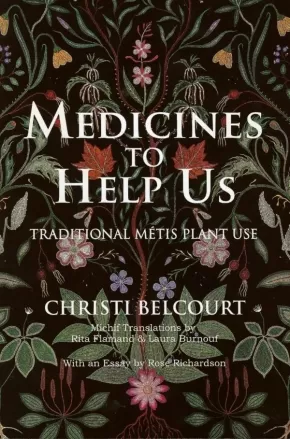
Métis
46
-
60
of
62 Results;
Sort By
Go To
of 5
This Place: 150 Years Retold
$39.00
Format:
Paperback
Text Content Territories:
Indigenous Canadian;
ISBN / Barcode: 9781553797586
Synopsis:
Synopsis:
Explore the past 150 years through the eyes of Indigenous creators in this groundbreaking graphic novel anthology. Beautifully illustrated, these stories are an emotional and enlightening journey through Indigenous wonderworks, psychic battles, and time travel. See how Indigenous peoples have survived a post-apocalyptic world since Contact.
Watch for new stories and familiar characters:
- Métis businesswoman Annie Bannatyne and Louis Riel
- Oka Crisis, Meech Lake Accord, and Kelowna Accord
- the Berger Inquiry into the Mackenzie Valley Pipeline
- Jack Fiddler, an Anishinaabe shaman charged as a serial killer
- Rosie, an Inuk girl coming of age during WWII
- wâpanacâhkos, an Indigenous woman sent back from the future to the early 2000s
- fishing raids and salmon wars in Listuguj, Quebec
- Francis Pegahmagabow, WWI sniper and veterans’ rights activist
- the impact of the Sixties Scoop and the child welfare system
- Chief Billy Assu and the potlatch bans in British Columbia
Reviews
Niigaanwewidam James Sinclair, one of the contributors to this work, says the book is, an “opportunity to shine a light on the stories most Canadians haven’t heard, to learn from Indigenous communities from 1867 to present day—whether these stories are influenced by the creation of Canada or not."
"…breathtaking comics anthology…this mix of powerful storytelling and memorable illustrations is a place to begin a dialogue with Indigenous peoples in Canada." —The Globe and Mail
"The anthology is visually gorgeous. Each story is powerfully conveyed, reflecting a time and moment in the Indigenous history of Canada…great read for any age." —Quill & Quire, starred review
"This Place is the graphic novel I’ve waited my whole life for, and the graphic novel Canada has needed for 150 years. The stories contained within its pages are both beautifully rendered and vitally necessary. They represent a history not only largely untold and unknown, but one obscured, hidden from sight, so that other stories may occupy a privileged place in the defining a national story. Their importance is exquisitely captured on these pages, told by some the leading artists working today. This is an essential book, for comic fans, teachers and anyone who wants to learn the stories of this place we now share." —Jesse Wente, broadcaster and film critic
"A landmark collection of Indigenous comics that redraws how we understand the past, present, and future of Indigenous communities and cultures since Confederation. Each chapter immerses us in a gripping story about real people brought to life through vivid and affecting artwork. This collection proves the power of comics storytelling to create fresh pathways to knowledge and new ways of envisioning Indigenous experiences." —Candida Rifkind, University of Winnipeg
"This is the power of storytelling. It’s going deeper and truer than the history books and the newspaper accounts. It’s bringing the stories to the people for the people and doing it for the right reasons: to teach and to illuminate. This Place: 150 Years Retold is the dawn to a new storytelling tradition that doesn’t need to be held back. It should be shouted forward from now on." —Helen Kubiw, CanLit for LittleCanadians
Educator Information
This graphic novel is recommended for ages 15+.
Recommended in the Canadian Indigenous Books for Schools 2019-2020 resource list for grades 7 to 12 for Art Education, English Language Arts, Law, and Social Studies.
These stories refer to real incidents and include graphic violence, abuse, and death.
A teacher's guide is available: This Place: 150 Years Retold Teacher Guide
Additional Information
250 Pages
Indigenous Peoples Atlas of Canada
$99.99
Format:
Hardcover
Text Content Territories:
Indigenous Canadian; Métis; Inuit; First Nations;
ISBN / Barcode: 9780986751622
Synopsis:
Synopsis:
Indigenous perspectives much older than the nation itself shared through maps, artwork, history and culture.
The Royal Canadian Geographical Society, in partnership with Canada's national Indigenous organizations, has created a groundbreaking four-volume atlas that shares the experiences, perspectives, and histories of First Nations, Inuit and Métis peoples. It's an ambitious and unprecedented project inspired by the Truth and Reconciliation Commission's Calls to Action. Exploring themes of language, demographics, economy, environment and culture, with in-depth coverage of treaties and residential schools, these are stories of Canada's Indigenous Peoples, told in detailed maps and rich narratives.
This extraordinary project offers Canada a step on the path toward understanding.
The volumes contain more than 48 pages of reference maps, content from more than 50 Indigenous writers; hundreds of historical and contemporary photographs and a glossary of Indigenous terms, timelines, map of Indigenous languages, and frequently asked questions. All packaged together in a beautifully designed protective slipcase.
Educator Information
Recommended for ages 13+.
The Indigenous Peoples Atlas of Canada includes a four volume print atlas, an online atlas, an app, and more!
Additional Information
322 pages | 10.50" x 12.87"
Métis Pioneers: Marie Rose Delorme Smith and Isabella Clark Hardisty Lougheed
$49.99
Format:
Paperback
Text Content Territories:
Indigenous Canadian; Métis;
Grade Levels: 12; University/College;
ISBN / Barcode: 9781772122718
Synopsis:
Synopsis:
In Métis Pioneers, Doris Jeanne MacKinnon compares the survival strategies of two Métis women born during the fur trade—one from the French-speaking free trade tradition and one from the English-speaking Hudson’s Bay Company tradition—who settled in southern Alberta as the Canadian West transitioned to a sedentary agricultural and industrial economy. MacKinnon provides rare insight into their lives, demonstrating the contributions Métis women made to the building of the Prairie West. This is a compelling tale of two women’s acts of quiet resistance in the final days of the British Empire.
Reviews
"[These two women's] individual paths provide interesting parallel stories about Métis women who survived and thrived as the Canadian west transitioned from the fur trade to a more sedentary agricultural economy. Marie Rose’s family was French-speaking Métis and a few served as Louis Riel’s soldiers. Isabella was from the English-speaking Métis stock. Both were born in 1861 and both married non-Indigenous men in unions that were influenced, or arranged outright, by their families. Both families had a strong history in the fur trade; Marie Rose’s were free traders and Isabella as part of the Hudson’s Bay Company. Both were community builders who later relied on their influence and circle of acquaintances for support after they became widows and fell on hard times. And the stories of both women showed how the Métis people continued to make significant contributions to the Canadian west even after the fur trade ended, an area of historical study that MacKinnon thinks is rife for discovery...." — Eric Volmers, Calgary Herald
"MacKinnon's book offers readers an in-depth look at the contributions each of the two women made to the growth of Canada's west, but more than that, it is a book about courage, resilience, determination and strength of character. The book was written to tell the truth..." — John Copley, Alberta Native News
"Whether or not the two women were ever in the same room together, their individual paths provide interesting parallel stories about Métis women who survived and thrived as the Canadian west transitioned from the fur trade to a more sedentary agricultural economy…And the stories of both women showed how the Métis people continued to make significant contributions to the Canadian west even after the fur trade ended, an area of historical study that MacKinnon thinks is rife for discovery."— Eric Volmers, Strength and Resilience
"This book deals with the lives of two frontier women - Isabella Lougheed and Marie Rose Smith. They both were Métis but their histories were miles apart. ... The author has found a rich source of history in these two women and offers them in a detailed account of their lives." — Alberta History
Additional Information
584 pages | 6.00" x 9.00"
Portraits of the North
$29.95
Artists:
Format:
Paperback
Text Content Territories:
Indigenous Canadian; First Nations; Anishinaabeg; Oji-Cree; Ojibway; Cree (Nehiyawak); Dene; Métis;
ISBN / Barcode: 9781988182414
Synopsis:
Synopsis:
This gorgeous book offers an incomparable glimpse into the experiences and history of more than one hundred First Nations and Métis elders from Canada’s North —“the last generation born on the land.” These stunning graphite pencil portraits are rendered with love, respect, and painstaking detail, along with gripping intimate profiles assembled from oral accounts and anecdotes. Their poignant facial features, lines, and creases, weathered by the harsh outdoors and a lifetime of challenges, are like badges of their remarkable achievements, sustained resolve, inspired patience, and deep-set defiance to the hardships their people have endured for generations. The masterful realism of Kuehl’s work helps uncover the tales of these seasoned individuals—their many triumphs and trials revealing in turn a greater portrait of life in the communities of Northern Canada, a compelling homage, and an enduring historical legacy. The portraits capture images of Cree, Ojibway, Oji-Cree, Dene and Métis peoples.
Additional Information
236 pages | 10.03" x 10.03"
Impact: Colonialism in Canada
$7.00
Format:
Paperback
Text Content Territories:
Indigenous Canadian;
Grade Levels: 12; University/College;
ISBN / Barcode: 9781927849293
Synopsis:
Synopsis:
A collection of fiction, poetry, essays and creative non-fiction, this anthology features works by over 20 Indigenous Canadian writers. The book focuses on the effects of colonialism in Canada from both historical and contemporary perspectives.
"These stories are rich in geographies Indigenous peoples journey through today; on streets, in cities, and into the future. These stories will make you think, cry, and heal." —Niigaanwewidam James Sinclair, Editor
Reviews
"Impact: Colonialism in Canada presents writings that are often challenging, thought-provoking, and at times, gut-wrenching. The collection is a testament to strength and resiliency and the potential for healing, both within the Indigenous and non-Indigenous communities. But, it is not easy reading; it demands considerable insight, open-mindedness, and an understanding of an historical concept (i.e. colonialism), all of which point to the book’s being read and/or studied by students in the upper grades of high school. It’s certainly a work that would be a fine reference in a high school library collection, and teachers would find it to be an excellent supplemental text for the study of Aboriginal writers, as well as Canadian history, particularly as a reflection of the impact of colonialism upon Canada’s Indigenous peoples. Highly Recommended." - Joanne Peters, CM Magazine
Educator Information
Recommended for ages 17+
Additional Information
198 pages | 5.50" x 8.50"
Speaking Our Truth: A Journey of Reconciliation
$29.95
Format:
Hardcover
Text Content Territories:
Indigenous Canadian;
ISBN / Barcode: 9781459815834
Synopsis:
Synopsis:
Canada's relationship with its Indigenous people has suffered as a result of both the residential school system and the lack of understanding of the historical and current impact of those schools. Healing and repairing that relationship requires education, awareness and increased understanding of the legacy and the impacts still being felt by Survivors and their families. Guided by acclaimed Indigenous author Monique Gray Smith, readers will learn about the lives of Survivors and listen to allies who are putting the findings of the Truth and Reconciliation Commission into action.
Educator Information
Recommended for grades 4 to 8.
A teacher guide for this resource is also available: Speaking Our Truth Teacher Guide
Additional Information
160 pages | 7.50" x 9.00"
Let Me See Your Fancy Steps: Story of a Métis Dance Caller
$25.00
Text Content Territories:
Indigenous Canadian; Métis;
ISBN / Barcode: 978-1-926795-83-6
Synopsis:
Synopsis:
“The Gabriel Dumont Institute Press is pleased to be able to preserve and share Jeanne Pelletier’s work and life story through Let Me See Your Fancy Steps—Story of a Métis Dance Caller. The Story of Jeanne Pelletier as told to Sylvie Sara Roy and Wilfred Burton. Jeanne’s achievement as the first female Métis dance caller is, of course, about Métis dance, but it is also about the determination of a young Métis girl who achieves her dream to become a dance caller during a time when this was only done by men.”
This resource includes dance calls for 16 dances and is accompanied by the instructional DVD All My Relations which features dance company V’ni Dansi which is led by renowned dancer and artistic director, Yvonne Chartrand.
Reviews
"The recounting of Jeanne’s work is supplemented throughout the book by testimonials of her former dance students and community members, all of whom praise the dance caller for the substantial impact that she’s had both on their personal lives, as well as the academic and social climates of the Métis community in Saskatchewan. As a Métis myself, I feel lost at times, as if my culture is fuzzy or foreign to me. Reading the life experiences, knowledge, and not to mention the wealth of Métis Jig steps found in this book gave me an overwhelming sense of peace to see research of this caliber and this level of care being invested in my culture. I would highly recommend this book to anyone with an interest in Métis culture and the significance that the jig has to the culture. Anyone who has seen the Métis Jig performed live knows that it is a beautiful and awe-inspiring dance, but after reading Jeanne’s explanations of the cultural significance of the dances, I will now appreciate the dance that much more as a story and celebration of my culture. It is also worth mentioning that entire dance sequences are written out to follow with Jeanne’s notes, and the book includes an instructional DVD." - Ben Charles for SaskBook Reviews
Educator Information
Recommended by Gabriel Dumont Institute for Secondary/Post Secondary/Adult.
Includes a DVD.
Recommended in the Canadian Indigenous Books for Schools 2019-2020 resource list as being useful for grades 5-12 with regard to these subjects: English Language Arts, Physical Education, Social Studies, Teacher Resource.
The Pemmican Eaters
$18.95
Format:
Paperback
Text Content Territories:
Indigenous Canadian; Métis;
ISBN / Barcode: 9781770412415
Synopsis:
Synopsis:
A picture of the Riel Resistance from one of Canada’s preeminent Métis poets.
With a title derived from John A. Macdonald’s moniker for the Métis, The Pemmican Eaters explores Marilyn Dumont’s sense of history as the dynamic present. Combining free verse and metered poems, her latest collection aims to recreate a palpable sense of the Riel Resistance period and evoke the geographical, linguistic/cultural, and political situation of Batoche during this time through the eyes of those who experienced the battles, as well as through the eyes of Gabriel and Madeleine Dumont and Louis Riel.
Included in this collection are poems about the bison, seed beadwork, and the Red River Cart, and some poems employ elements of the Michif language, which, along with French and Cree, was spoken by Dumont’s ancestors. In Dumont’s The Pemmican Eaters, a multiplicity of identities is a strengthening rather than a weakening or diluting force in culture.
Awards
- Winner of the 2016 Stephan G. Stephansson Award for Poetry
Reviews
“A rollicking poem about the fiddle ('the first high call of the fiddle bids us dance/baits with its first pluck and saw of the bow/reels us, feet flick — fins to its lure and line') becomes a statement of cultural pride and defiance — much like The Pemmican Eaters as a whole.” — Toronto Star
“Dumont’s work is visual and evocative, highlighting recurring symbols and images of a natural world that will be familiar to any dweller of the Prairies . . . The Pemmican Eaters builds off the poet’s earlier work and highlights a writer who has mastered both craft and voice.” — Quill & Quire
“Dumont honours Métis traditions in music and beadwork in a number of lyrically driven poems. The Pemmican Eaters is a statement of cultural pride and defiance, much like Marilyn herself.” — CBC News Online
“Marilyn Dumont uses both rhythmic and free verse to provide a brilliant and insightful look at Métis and Cree people.” — Scene Magazine
Educator Information
This book would be useful for grades 9 - 12 in courses such as creative writing, English language arts, and social studies. Also recommended for students a college/university level.
Additional Information
96 pages | 5.50" x 8.50"
Residential Schools, With the Words and Images of Survivors
$34.95
Format:
Hardcover
Text Content Territories:
Indigenous Canadian;
ISBN / Barcode: 9780993937101
Synopsis:
Synopsis:
Residential Schools, With the Words and Images of Survivors, A National History honours the survivors, the former students, who attended residential schools. Designed for the general reader this accessible, 112-page history offers a first-person perspective of the residential school system in Canada, as it shares the memories of more than 70 survivors from across Canada as well as 125 archival and contemporary images (65 black & white photographs, 51 colour, some never before published).
This essential volume written by award-winning author Larry Loyie (Cree), a survivor of St. Bernard Mission residential school in Grouard, AB, and co-authored by Constance Brissenden and Wayne K. Spear (Mohawk), reflects the ongoing commitment of this team to express the truths about residential school experiences and to honour the survivors whose voices are shared in this book.
Along with the voices, readers will be engaged by the evocative, archival photographs provided by the Shingwauk Residential Schools Centre with the assistance of curator Krista McCracken. The book begins with the moving introduction by Larry Loyie, and moves to seven chapters that explore the purpose of this school system; cultures and traditions; leaving home; life at school the half-day system; the dark side of the schools; friendship and laughter coping with a new life; changing world–the healing begins; and an afterword. A detailed, full colour map showing residential schools, timeline with key dates, glossary, and a helpful index (including names of survivors and schools) make this vital resource a must-have for secondary, college, and universities, libraries, and the general reader.
Reviews
"A broad and comprehensive review of the history of First Nations, Métis, and Inuit peoples in Canada told from the perspective of First Peoples in a very accessible way. Any educator, regardless of personal background or heritage, would find this timely resource very useful in any classroom." — Gary Fenn and Domenic Bellissimo, executive assistants, Ontario Secondary School Teachers’ Federation
"Written with a gentle hand, this book describes a history that few Canadians understand or even know about. From the first page, those in search of the truth are engaged in a journey of learning, as they come to understand the true battle of Aboriginal peoples to preserve their cultures and pride. This story is a true account of resiliency and human spirit." — Tracy Zweifel, executive director, Sagitawa Friendship Society, Alberta
Awards
- 2016 Winner of Golden Oak award in Ontario's Forest of Reading program
Educator Information
This must-have resource includes a detailed, full-colour map showing residential schools, a timeline with key dates, and a glossary.
Recommended for grades 7-12, but would still be useful for adults and college/university courses studying residential schools and Indigenous history.
This book has been evaluated and approved by ERAC (Educational Resource Acquisition Consortium, British Columbia).
Additional Information
112 pages | 10.43" x 8.26"
Aboriginal Music in Contemporary Canada: Echoes and Exchanges
$55.00
Editors:
Format:
Hardcover
Text Content Territories:
Indigenous Canadian; First Nations; Inuit; Métis;
ISBN / Barcode: 9780773539518
Synopsis:
Synopsis:
First Nations, Inuit, and Métis music in Canada is dynamic and diverse, reflecting continuities with earlier traditions and innovative approaches to creating new musical sounds. Aboriginal Music in Contemporary Canada narrates a story of resistance and renewal, struggle and success, as indigenous musicians in Canada negotiate who they are and who they want to be. Comprised of essays, interviews, and personal reflections by Aboriginal and non-Aboriginal musicians and scholars alike, the collection highlights themes of innovation, teaching and transmission, and cultural interaction. Individual chapters discuss musical genres ranging from popular styles including country and pop to nation-specific and intertribal practices such as powwows, as well as hybrid performances that incorporate music with theatre and dance. As a whole, this collection demonstrates how music is a powerful tool for articulating the social challenges faced by Aboriginal communities and an effective way to affirm indigenous strength and pride. Juxtaposing scholarly study with artistic practice, Aboriginal Music in Contemporary Canada celebrates and critically engages Canada's vibrant Aboriginal music scene. Contributors include Véronique Audet (Université de Montreal), Columpa C. Bobb (Tsleil Waututh and Nlaka'pamux, Manitoba Theatre for Young People), Sadie Buck (Haudenosaunee), Annette Chrétien (Métis), Marie Clements (Métis/Dene), Walter Denny Jr. (Mi'kmaw), Gabriel Desrosiers (Ojibwa, University of Minnesota, Morris), Beverley Diamond (Memorial University), Jimmy Dick (Cree), Byron Dueck (Royal Northern College of Music), Klisala Harrison (University of Helsinki), Donna Lariviere (Algonquin), Charity Marsh (University of Regina), Sophie Merasty (Dene and Cree), Garry Oker (Dane-zaa), Marcia Ostashewski (Cape Breton University), Mary Piercey (Memorial University), Amber Ridington (Memorial University), Dylan Robinson (Stó:lo, University of Toronto), Christopher Scales (Michigan State University), Gilles Sioui (Wendat), Gordon E. Smith (Queen's University), Beverly Souliere (Algonquin), Janice Esther Tulk (Memorial University), Florent Vollant (Innu) and Russell Wallace (Lil'wat).
Additional Information
520 pages | 6.14" x 9.25"
Authenticity Note: While the editors of this book are not Indigenous, the majority of contributors are Indigenous; therefore, this book has received the Authentic Indigenous Text label.
Manitowapow: Aboriginal Writings from the Land of Water
$35.00
Editors:
Format:
Paperback
Text Content Territories:
Indigenous Canadian; First Nations; Inuit; Métis;
ISBN / Barcode: 9781553793076
Synopsis:
Synopsis:
This anthology of Aboriginal writings from Manitoba takes readers back through the millennia and forward to the present day, painting a dynamic picture of a territory interconnected through words, ideas, and experiences. A rich collection of stories, poetry, nonfiction, and speeches, it features:
- Historical writings, from important figures.
- Vibrant literary writing by eminent Aboriginal writers.
- Nonfiction and political writing from contemporary Aboriginal leaders.
- Local storytellers and keepers of knowledge from far-reaching Manitoba communities.
- New, vibrant voices that express the modern Aboriginal experiences.
- Anishinaabe, Cree, Dene, Inuit, Métis, and Sioux writers from Manitoba.
Educator & Series Information
Created in the spirit of the Anishinaabe concept debwe (to speak the truth), The Debwe Series is a collection of exceptional Aboriginal writing from across Canada. Manitowapow, a one-of-a-kind anthology, is the first book in The Debwe Series. Manitowapow is the traditional name that became Manitoba, a word that describes the sounds of beauty and power that created the province.
Recommended for grades 11 and 12, university students, and adults.
Additional Information
416 pages | 6.00" x 9.00"
Gabriel Dumont Speaks: Revised 2nd Edition
$16.95
Format:
Paperback
Text Content Territories:
Indigenous Canadian; Métis;
ISBN / Barcode: 9780889226258
Synopsis:
Synopsis:
Gabriel Dumont's memoirs present a rare view of Métis history as told by one of their key heros.
In 1903, eighteen years after leading the Métis Army against the Northwest Expeditionary Force and the Northwest Mounted Police at Fish Creek, Duck Lake and Batoche, Louis Riel’s Adjutant General Gabriel Dumont dictated his memoirs to a group of friends, one of whom is thought to have written Dumont’s stories out in longhand during that epic meeting. This manuscript languished unseen and unpublished in the Manitoba Provincial Archives as part of L’Union nationale métisse de Saint-Joseph collection until its discovery there by Michael Barnholden in 1971. Now re-translated into English, it preserves the record of an unrepeatable oral recital, offering us a rare opportunity to view one of the central events in the history of the Métis in a new context: as perceived by one of their key heroes.
Like Riel, Dumont put the interest of his people ahead of his own. Although he could neither read nor write, he was an eloquent speaker, sought after to defend Métis rights both in Canada and the United States throughout the 1880s and 1890s. Known to have spoken Blackfoot, Sioux, Crow, Cree, French and English, Dumont dictated his memoir in “incipient Michif,” thought to be his first language: using Cree syntax and some verbs, with a vocabulary that was primarily French.
Dumont’s first-person account of the details of his early life, leading up to the events variously referred to as the Riel Rebellion, the Northwest Rebellion or the War of 1885, provide a third reading of the “Rebellion” from the point of view of its military leader, as well as many personal, cultural and historical revelations worthy of examination. In addition, Dumont’s sheer strength of narrative carries these decisive events with a conviction, drama and suspense that only the tradition of oral history can deliver.
Louis Riel: Firebrand (1 in Stock) - ON SALE!
$13.00 $17.95
Format:
Paperback
Text Content Territories:
Indigenous Canadian; Métis;
ISBN / Barcode: 9781894852265
Synopsis:
Synopsis:
Louis Riel devoted his life to the Métis cause. A fiery activist, he struggled against injustice as he saw it. He was a pioneer in the field of Aboriginal rights and land claims but was branded an outlaw in his own time. In 1885, he was executed for treason. In 1992, the House of Commons declared Riel a founder of Manitoba. November 16 is now designated Louis Riel Day in Canada.
Additional Information
208 pages | 5.50" x 8.50"
Medicines to Help Us: Traditional Métis Plant Use
$25.00
Artists:
Text Content Territories:
Indigenous Canadian; Métis;
ISBN / Barcode: 9780920915790B
Synopsis:
Synopsis:
Based on Métis artist Christi Belcourt’s painting “Medicines to Help Us,” this innovative and vibrant resource honours the centuries-old healing traditions of Métis women. With contributions from Métis Elders Rose Richardson and Olive Whitford, as well as key Michif phrases and terminology, Medicines to Help Us is the most accessible resource relating to Métis healing traditions produced to date.
Educator Information
This resource guide does not include the study prints referred to on the back cover and within the book.
Michif Translators: Laura Burnoff and Rita Flamand
Elder Validation: Rose Richardson
Format: Book Only - English, with plant names in Michif, Nehiyawewin (Cree), and Anishinaabemowin (Ojibway)
Howard Adams: Otapawy!: The Life of a Metis Leader in His Own Words and in Those of His Contemporaries
$6.00
Editors:
Format:
Paperback
Text Content Territories:
Indigenous Canadian; Métis;
ISBN / Barcode: 0-920915-74-4
Synopsis:
Synopsis:
Passionate and engaging, Howard Adams: OTAPAWY! is an immense contribution to our knowledge of modern Métis political consciousness and activism. In addition to being Howard Adams’ own record of his remarkable life, the book also contains many contributions by those who were touched by him as a friend, colleague, mentor, activist, political leader, teacher, and scholar.
Augmented by an interactive CD-ROM containing dozens of photographs and documents relating to Howard Adams’ life and work.
Educator Information
Grade Level: Secondary/Post Secondary/Adult
Additional Information
310 Pages | Nonfiction
Sort By
Go To
of 5

